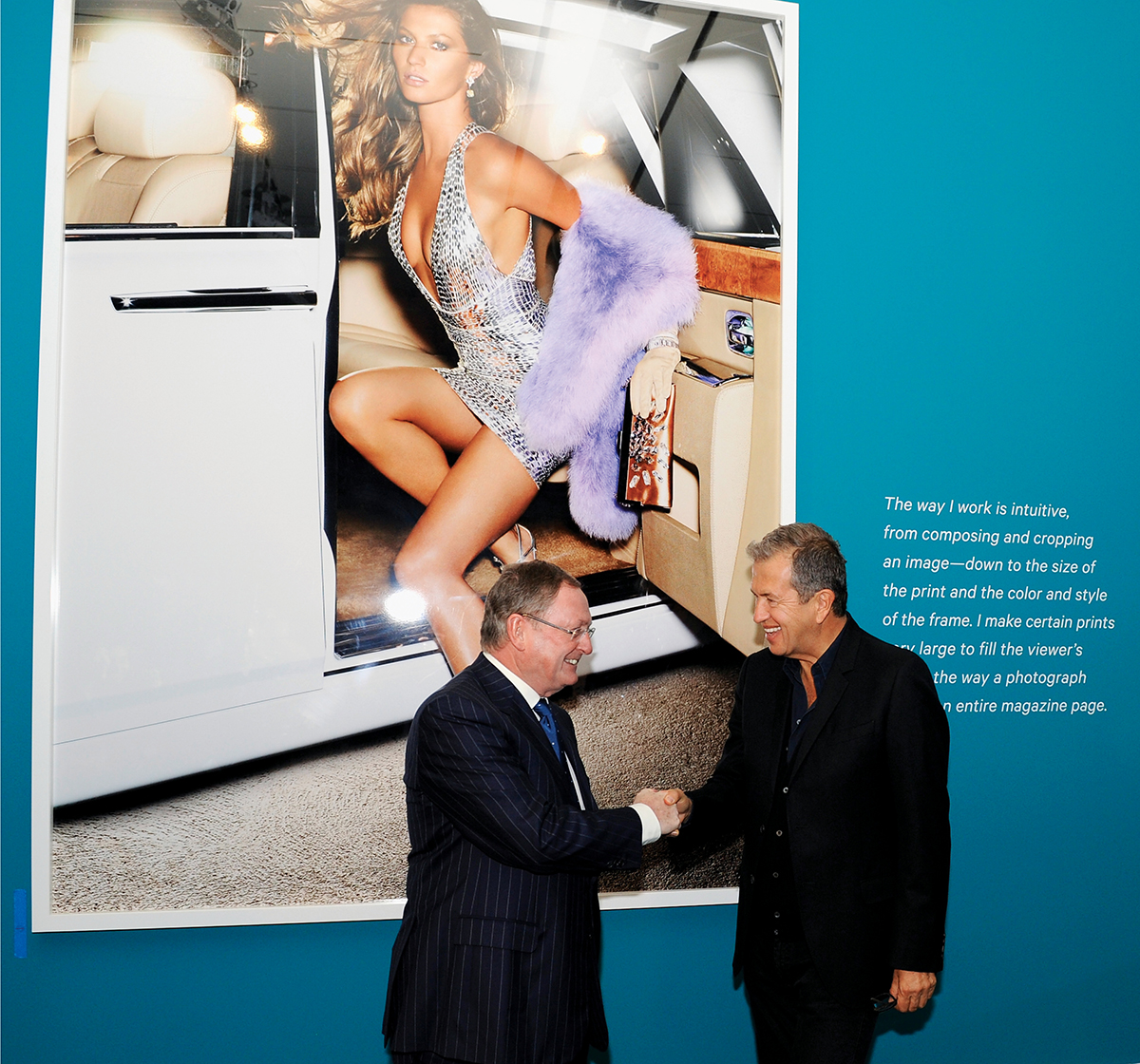Malcolm Rogers Has Left the Building

Malcolm Rogers courted celebrities and high-profile artists such as photographer Mario Testino (right), whose work was showcased at the MFA in 2012. / Photograph by Paul Marotta/Getty Images
Over the years, the museum expanded several times, but the demographics of its audience remained largely white and middle- to upper-middle class. There was a long-held perception in Boston that the MFA was not welcoming to other ethnic and socioeconomic groups. Melton, the longtime archivist, remembers that as a child who grew up in a working-class family outside of Boston, she felt distanced from the museum. “I would get dressed up to go to the MFA and be nervous,’’ she recalls. Despite the occasional blockbuster, many of the galleries were all but empty during the years leading up to Rogers’s appointment.
The economy didn’t do the MFA any favors during the early 1990s, when the museum ran large deficits. Morale hit rock bottom in June 1991, when the board ordered the administration to trim $1.7 million off a projected $4.7 million deficit. Forty-two positions were affected, and 21 people were laid off. The financially strapped museum had borrowed an estimated $6 million to $10 million off its endowment, which had decreased to $145 million. Then–board president and financier George Putnam arrived late to a staff meeting that had been called to announce the bad news. “I do find that bad things happen in threes,’’ he told the group of staffers, trustees, and overseers. “I broke a tooth this morning. My train broke down in Beverly. The third thing…” One longtime museum donor waved a $5 bill in the air, offering to take up a collection to fix Putnam’s tooth.
Putnam’s insensitive comments didn’t go over well. The curators fired off a furious letter, and members of the board agreed that they had been remiss in handling the financial crisis that was hitting major museums all over the country. The MFA was in deep trouble. Something needed to change.
This was the museum inherited by the young Englishman I met skulking about the elevator at the Ritz. At best, though, Rogers seemed a curious choice to stage a dramatic turnaround. Raised on a rural Yorkshire farm, he won a scholarship to a prestigious secondary school and another to Oxford, where he excelled. “I’m a fairly conservative fellow,’’ he says now—an intentionally provocative salvo from a man who courted celebrities and displayed their work on the museum’s walls.
When Rogers arrived in Boston, he said he was astonished that the largest gift to the museum to date had been a mere $2.5 million. Early in his tenure, he invited the architect Graham Gund and his wife, Ann, to dinner. “Graham had been on the board since 1974, and he said, ‘My goodness, no director has ever asked me to dinner before,’’’ Ann recalls. Shortly after the dinner, the MFA’s director of development called, not coincidentally, to ask the Gunds to endow the directorship, and Rogers became the first Ann and Graham Gund Director.
A few months into his tenure, in February 1995, Rogers initiated layoffs in an attempt to trim $3.4 million off the museum’s $4.5 million deficit. But he initially avoided the kind of furor that had erupted four years earlier by announcing the layoffs in advance and consulting with curators before decisions were made. (He also refrained from making any quips about dental distress.) Rogers made good on his promise to open the doors on Huntington Avenue, a symbolic gesture that was universally applauded. “I do feel that the museum was perceived as a grand, stately dowager, and in some ways we were,’’ he says. “The brand had to be broken. We had to show change.”
Few people at the MFA, however, were ready for the kind of change Rogers had in store. In June 1999, he launched a blood-letting that was immediately dubbed “The Boston Massacre.” In an event that roiled the rumor-obsessed art world, Rogers unexpectedly restructured the museum, eliminating 18 positions, creating 20 new ones, and carving out new “ super” departments organized by geography rather than discipline. He dismissed two prominent curators who had brought cachet and donors to the museum: Jonathan Fairbanks, the curator of American decorative arts and sculpture, who had been at the museum for 28 years; and Anne Poulet, the curator of European decorative arts, who had been there for 20 years. Both curators were summoned to the executive offices, had their badges confiscated, and were escorted out of the building. “After 30 years, I hadn’t expected it,” says Fairbanks, who, at 82, is now director of the Fuller Craft Museum, in Brockton. “I would have preferred to leave in another way.”
Rogers said the move was part of his goal to create “one museum,” and that it was necessary to dismantle powerful curatorial “fiefdoms.” “I wanted to bring a new professional model where everyone worked together for the museum and respected the professionalism of other colleagues,” Rogers says.
The idea of “one museum,” however, turned out to be an institution with one director at the top who diminished curatorial control and micromanaged decisions. Members of the board were stunned and furious about the brutal way the reorganization was handled. Ted Stebbins, who had been promoted to chair of the new Art of the Americas department, resigned angrily a few months later. He showed up at 9 a.m. with his lawyer and handed a letter of condemnation to Rogers. “It was really an outrageous thing to do,’’ Stebbins says today of the layoffs. “It was more than a shot across the bow. It was a real wounding of the curatorial staff.” Stebbins, known for securing such prestigious donations as the 20th-century American paintings in the Lane Collection, was irate that his colleagues were treated like “criminals,” but he was also concerned that every decision about the proposed new Art of the Americas Wing would be made by Rogers. “It turns out that I was absolutely right,” he says. “I have heard from the curators that Malcolm interfered in every aspect of the installation, choosing the awful wallpapers and even rearranging the works in most galleries after the curators had finished.” Rogers says that he did “very little of that,” although he confesses gleefully that those in charge of installing the Art of the Americas Wing “allowed me to edit a little” and that it is “a privilege to be used as a confidant by some of the curators.”
Benjamin Weiss, now the MFA’s chair of prints, drawings, and photographs, was tasked with writing labels for the new galleries. Rogers, he says, was not shy about tweaking his copy. “Malcolm is an extraordinarily skilled editor,” Weiss tells me. “You are a writer. I am sure you know that a good edit is like a bracing massage.”
Weiss relished the collaboration, he says. But some board members say Rogers’s hands-on style intimidated other curators. After the so-called Boston Massacre, external criticism was fast and furious. Patricia Hills, professor emerita of American art and African-American art at Boston University, was vocal in her support of the curators and in her belief that the reorganization was the final blow in what she views as the “corporate model” of the museum. “The curators’ stature was reduced,’’ she says. “It is a model of management that is very top down rather than collaborative.”
David Ross, who as former director of Boston’s Institute of Contemporary Art and New York’s Whitney Museum of American Art is hardly a member of the old guard, is still furious. “You don’t treat curators like fungible assets,” he says. Ross, who led the ICA during the infamous Robert Mapplethorpe exhibit in 1990 and was then a mentor to newly appointed MFA director Matthew Teitelbaum, breathes fire when he discusses Rogers. In his view, Rogers was a success according to “the show business metric”—that is, by a measure of generated income and attendance, not artistic excellence. “They are doing the same things they do in the retail and entertainment industries. Why else would you build a giant empty space for corporate parties that is like a carbuncle on the building?” he asks, referring to the huge spaces that house the visitor center and the café. “It is an embarrassment, just like it was an embarrassment to put [Bill] Koch’s boats on the fucking lawn.”
Despite opening up the museum to wider communities, Rogers managed to anger the working-class folks in charge of welcoming those visitors, leading an administration that was in a constant push and pull with the MFA’s Independent Security Union. In 2005, the union took to the streets during the opening party for the Koch exhibit, and its members refused to work overtime for the event. Two days after the party, then–union president Michael Raysson, who is now retired, published on op-ed in the Globe that ended with the blast: “The museum should be setting examples for corporations like Walmart, instead of taking lessons from them.” As for the mega store known for underpaying its employees, Rogers says, “I know nothing about Walmart, and I wouldn’t want to make a comparison. But anywhere you can find a bargain, I’m there.”
Rogers also created a rift on the board when he started using the collection as a cash cow. He has lent out more artworks than any other director in the history of the museum, including sending a cache of Monets to the Bellagio hotel in Las Vegas, which brought in at least a cool million for the museum. When I mention the Las Vegas deal, Rogers responds quickly. “Have you been there?” he asks. “Somehow the name Las Vegas brings out an inherent East Coast Puritanism. Our mission is to take art to the people.” But at least one board member quit over the fact that the museum continues to send its art around the world for a price. The mission of the museum is to collect and preserve the collections, not to use them as revenue sources, according to some board members. The board has been divided over this issue, and several members (particularly the serious collectors) have roundly criticized and challenged this practice behind closed doors.
Rogers, for his part, is stepping down without any regrets. “There is nothing I am profoundly disappointed with,’’ he says. But everyone I asked about the Boston Massacre said his handling of the reorganization was less than ideal. Except one. Rogers, to this day, refuses to admit that he made a mistake.


